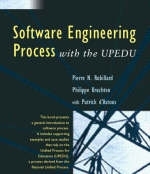
Software Engineering Processes
Pearson (Verlag)
978-0-201-75454-4 (ISBN)
- Titel ist leider vergriffen;
keine Neuauflage - Artikel merken
This book provides a general introduction to the essentials of the software development process, that series of activities that facilitate developing better software in less time. It starts with the basic aspects of software process which are the methods, tools and the concepts of the software life cycle. The second and third parts emphasize the engineering and management disciplines that are the core of any software engineering process. The fourth part, which is concerned with the quality aspects of software process, presents the aspects of process assessment and measurement. The last chapter introduces a software process metamodel, which is the theoretical foundation for any software process.
The approach is general, and the explanations are not tied to a particular commercial process. The book includes an ongoing case study example which does use the Unified Process for Education, which is derived from The Rational Unified Process. This book thus enables readers to gain experience with some of the basics of the Rational Unified Process—the industry's most powerful tool for incorporating the best practices into software development—and prepares them to work with any organization's software process.
The book includes a robust Website with all the sample deliverables and artifacts created from the case study, as well as chapter-by-chapter sections with further, up-to-date readings on process advancements, the PDF files for all the figures in the book, links to Software Engineering news sites, chapter by chapter information on commercial tools, industry standards, etc.
I. BASIC ASPECT OF SOFTWARE PROCESS.
1. The Needs for Software Process and Case Study.
Specifying a One Week Project.
Developing a One Week Project.
Learning from Basic Software Engineering Process.
Specifying the Case Study.
Exercises.
Reading.
Short Story.
2. Software Process and Software Life Cycle.
Understanding the Development Evolution of Software.
Defining the Software Life Cycle and the Software Process.
Defining Elements of the Software Process.
Integrating the Software Life Cycle and the Software Process.
Customizing the Software Process.
Summary.
Exercises.
Readings.
Cyber Reading.
3. Models and Tools.
Why are Models and Tools Necessary?
Modeling Concepts.
Modeling Diagrams.
Finding the Right Case Tools.
Summary.
Exercises.
Review Questions.
Cyber Reading.
Readings.
Short Story.
II. ENGINEERING ASPECTS OF SOFTWARE PROCESS.
4. Requirements Discipline.
Presenting the Scope of Requirements.
Defining the Requirements Artifacts.
Eliciting Requirements.
Evolving Requirements.
Exercises.
Cyber Reading.
Readings.
Short Story.
5. Analysis and Design Discipline.
Introducing the Crystallization Analogy.
Understanding the Analysis and Design Principle.
Defining the Analysis and Design Activities.
Documenting the Analysis and Design Discipline.
Viewing the Model.
Exercises.
Cyber Reading.
6. The Implementation Discipline.
Understanding the Implementation Discipline.
Realizing the Implementation Discipline.
Elaborating the Implementation Discipline.
Presenting a Construction Phase Iteration.
Exercises.
Cyber Reading.
Readings.
7. Test Discipline.
Relating Testing to Quality.
Defining Test Discipline Activities.
Elaborating the Test Discipline.
Evaluating Testing Activities.
Exercises.
Cyber Reading.
Readings.
Short Story.
III. MANAGEMENTS ASPECTS OF SOFTWARE PROCESS.
8. The Software Configuration and Change Management Discipline.
Defining the Discipline.
Highlighting Operational Aspects of the Discipline.
Managing the Software Configuration and Change Discipline.
Implementing Software Configuration and Change Management.
Summary.
Exercises.
Cyber Reading.
Readings.
Short Story: Chaos, Big Bang, and Beyond.
9. Project Management Discipline.
Defining the Project Manager Role.
Planning Projects.
Managing Iterations.
Managing Risks.
Exercises.
Cyber Reading.
Readings.
Short Story: On Climbing Big Mountains.
10. Team.
Understanding Teams.
Structuring Team Environments.
Defining Team.
Building a Team.
Supporting Team Activities.
Exercises.
Cyber Reading.
Readings.
Short Story: Managing Teams.
IV. QUALITY ASPECTS OF SOFTWARE PROCESS.
11. Process Assessment and Improvement.
Defining Process and Reference Models.
Registration and Certification.
Assessing UPEDU.
Exercises.
Cyber Reading.
Readings.
Short Story.
12. Software Process Measurement.
Measuring Process Activities.
Defining Measurement Paradigms.
Measuring Effort.
Measuring Cognitive Activities.
Exercises.
Cyber Reading.
Readings.
13. A Process Engineering Metamodel.
Metamodeling.
Structuring the Metamodel.
Overviewing Unified Software Process Metamodel.
Exercises.
Cyber Reading.
Readings.
Short Story.
| Erscheint lt. Verlag | 16.9.2002 |
|---|---|
| Sprache | englisch |
| Maße | 231 x 202 mm |
| Gewicht | 689 g |
| Themenwelt | Informatik ► Office Programme ► Outlook |
| ISBN-10 | 0-201-75454-1 / 0201754541 |
| ISBN-13 | 978-0-201-75454-4 / 9780201754544 |
| Zustand | Neuware |
| Informationen gemäß Produktsicherheitsverordnung (GPSR) | |
| Haben Sie eine Frage zum Produkt? |
aus dem Bereich


